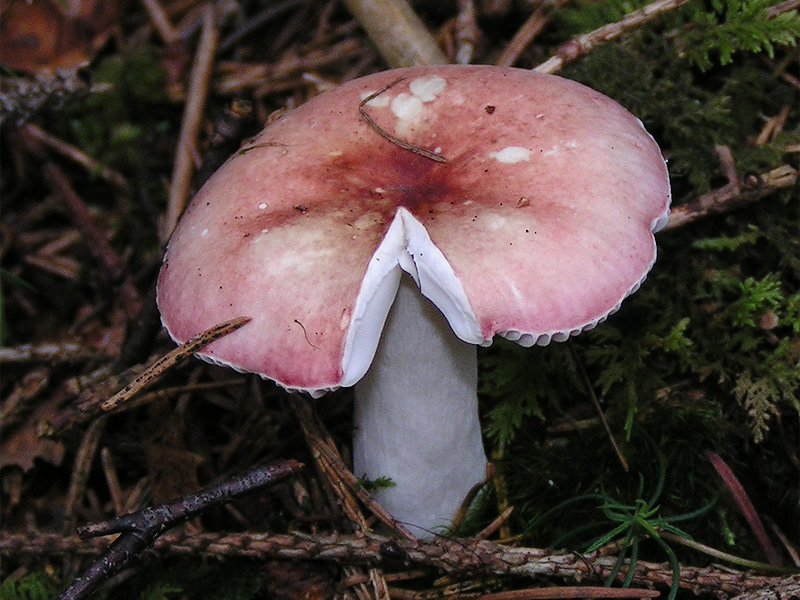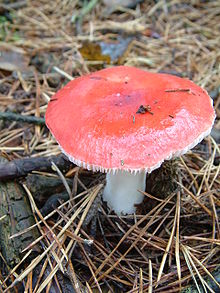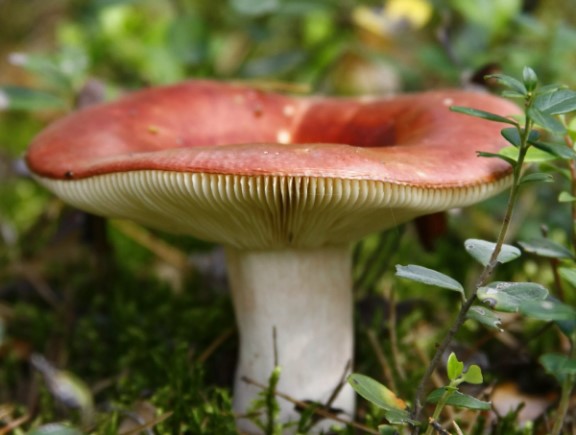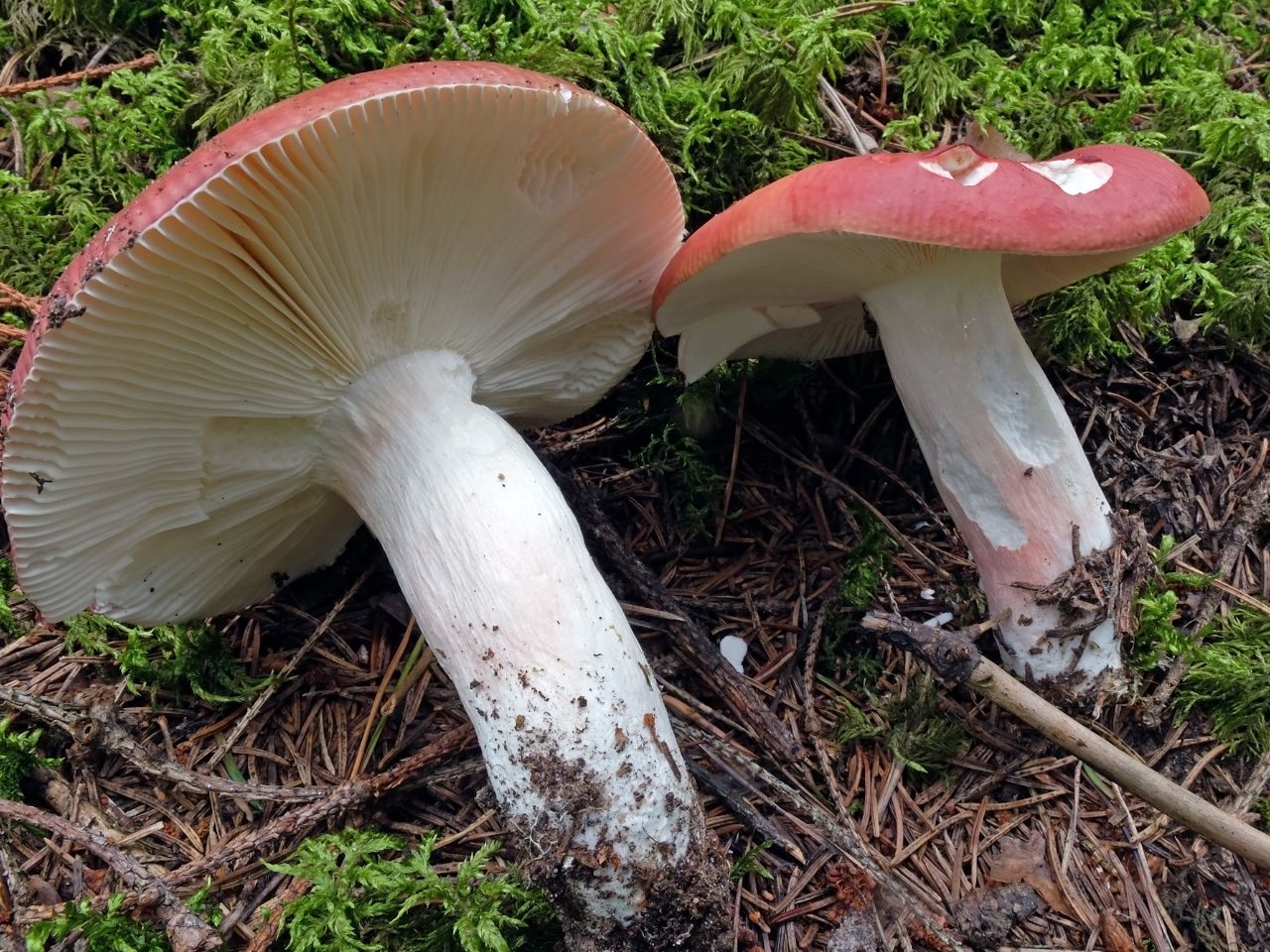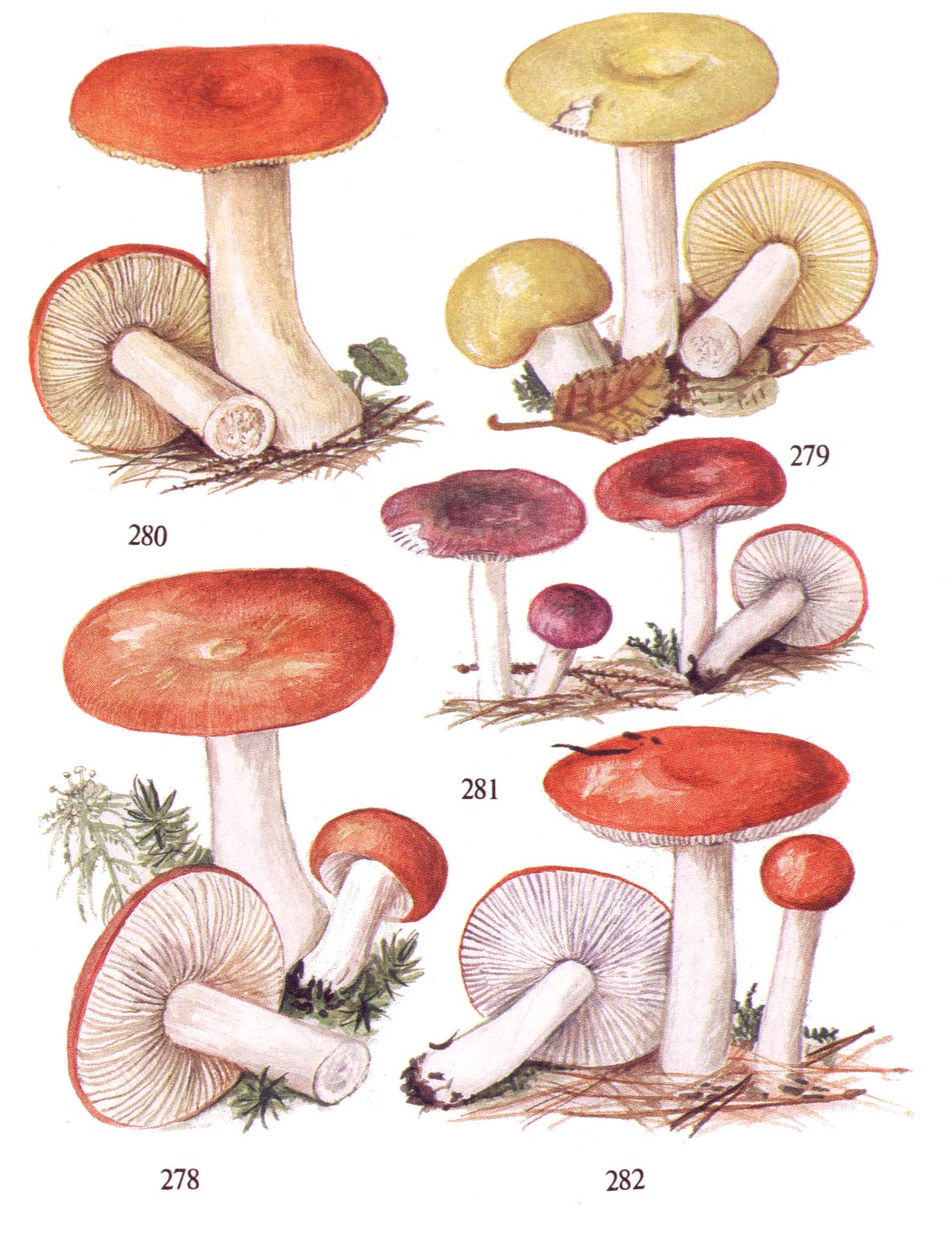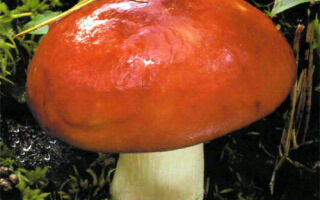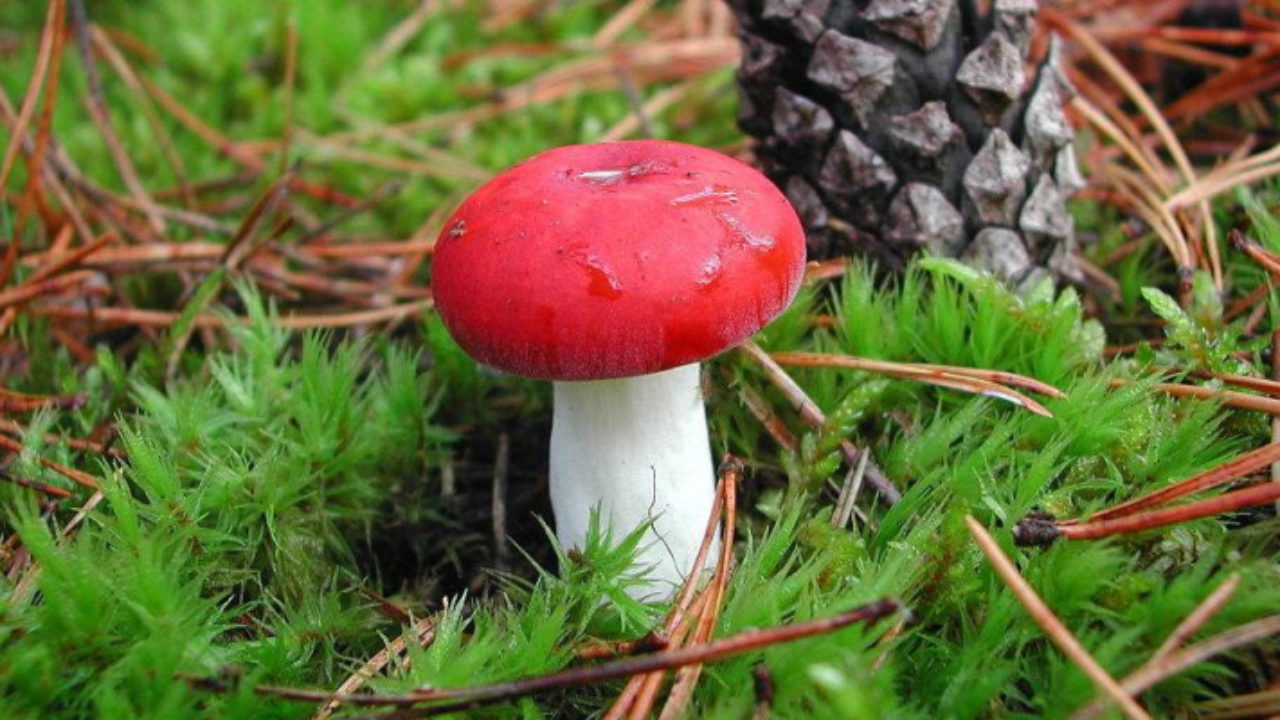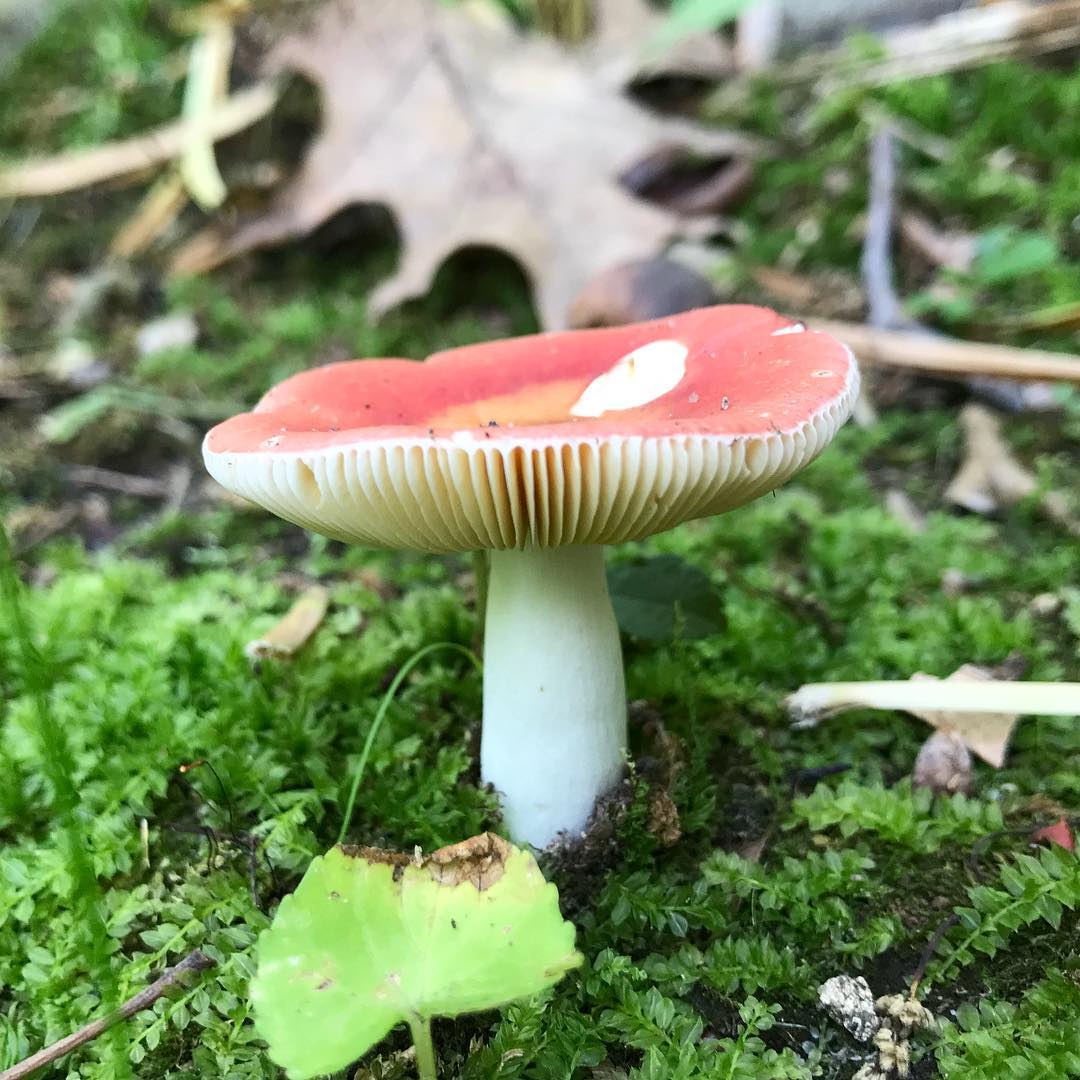Edible russula greenish and its photo
Category: edible.
Cap of a greenish russula (Russula virescens) (diameter 5-16 cm): green, but can be yellowish or bluish. In young mushrooms it is hemisphere-shaped, in older mushrooms it is spread. Fleshy, often cracked. The skin is very thick, it is difficult to separate from the pulp.
Leg (height 4-12 cm): usually white.
If you look closely at the photo of the greenish russula, you can see small scales at the very base of the leg.
Plates: frequent, white or light cream color.
Flesh: firm and whitish, slightly pungent in taste.
Doubles: the greenish representatives of the pale toadstool (Amanita phalloides), differ from the russula in that they have a ring on the leg and a volva.
This edible russula grows from mid-July to early October in temperate countries.
Where can you find it: in deciduous and mixed forests, most often in the vicinity of oaks and birches.
Eating: one of the most delicious russula, which can be eaten after 15 minutes of boiling, pickled, salted or dried.
Application in traditional medicine: not applicable.
Other names: russula scaly.
What are edible russula: food
Category: edible.
Hat for food russula (Russula vesca) (diameter 4-12 cm): matte, pink-red, brick or red-brown. In young mushrooms, it is hemispherical, becoming almost flat over time. Slightly sticky to the touch in wet weather. The edges are bent towards the inner side, sometimes wavy and ribbed. The skin does not completely cover the flesh, exposing the plates at the edges, it is easily removed only from the edges.
Leg (height 3-7 cm): white, yellow or pink-rusty, very short, cylindrical. Dense in young mushrooms, hollow in older ones.
The plates of this species of russula mushrooms are very frequent, white or yellowish, sometimes with rusty spots.
Pay attention to the photo of food russula: its pulp is fleshy and dense, white, brittle. No pronounced odor
Doubles: russula relatives, but only the food peel does not cover the plates.
When it grows: from mid-July to late September in Europe.
Where to find it: In all types of forests, especially in the vicinity of birches and oaks.
Eating: delicious mushroom. It is used in any form, provided that it is boiled for 15 minutes.
Application in traditional medicine: not applicable.
Other names: edible russula.
Description of the species
The caps of young russules can have a spherical or bell-shaped shape, in the process of growth they straighten and become flat or funnel-shaped. Their dryish film, depending on the type, has a very different color and can be either shiny or matte. The inner part of the caps is covered, depending on the variety, with frequent or rare, brittle descending plates of white or pale yellow color.
Russula have a fairly dense, but very fragile white pulp. Cylindrical hollow legs are even, less often thickened towards the base. Mushrooms are distinguished by a delicate, sweetish aroma with fruity notes and a nutty taste. In addition to the delicious edible russula, there are species that have a bitter and pungent taste and are completely unsuitable for consumption.
That is why it is important to know the signs of both.

Kele's russula (Russula queletii)
Synonyms:
- Russula sardonia f. queletii
- Russula flavovirens
Kele's russula is considered one of the few russules that can be easily identified by the combination of the following features:
- the predominance of purple flowers in the color of the cap and legs
- growing near conifers
- off-white spore print
- acrid taste
Ecology
Forms mycorrhiza with conifers, especially spruce and some types of pines (two-needled pines). Curiously, the European Kele russula is considered to be more tied to spruce trees, while the North American ones come in two "versions", some associated with spruce and others associated with pines.
Description
Hat: 4-8, up to 10 centimeters. In youth, fleshy, semicircular, convex, later - flat-convex, with age, prostrate, depressed-prostrate. In very old specimens, the edge is wrapped up. Sticky, sticky in young mushrooms or in wet weather. The skin of the cap is smooth, shiny.
The color of the cap in young specimens is dark blackish-purple, then becomes dark purple or brownish-violet, cherry-violet, purple, purple-brownish, sometimes greenish tints may be present, especially at the edges.
Plates: widely accreted, thin, white, with age, acquire a creamy, later - yellowish color.
Leg: 3-8 centimeters long and 1-2 centimeters thick. Color from pale purple to deep purple or pinkish purple. The base of the stem can sometimes be colored in shades of yellow.
Smooth or slightly pubescent, matte. Dense, fleshy, whole. With age, voids form, the pulp becomes brittle.
Flesh: white, firm, dryish, brittle with age. Under the skin of the cap - purple. Almost does not change color on cut and when damaged (it may turn yellow quite a bit).
Spore powder: from white to cream. Spores: ellipsoidal, 7-10 * 6-9 microns, warty. Chemical reactions: KOH on the surface of the cap gives a reddish-orange color. Iron salts on the surface of the leg: pale pink.
Smell: pleasant, almost indistinguishable. Sometimes it can seem sweetish, sometimes fruity or sour.
Taste: acrid, spicy. Unpleasant.
Season and distribution
Grows singly or in small groups in coniferous and mixed forests (with spruce).
Occurs from mid-summer to late autumn. Different sources indicate different ranges: July - September, August - September, September - October.
Widespread in the Northern Hemisphere (possibly in the Southern).
Edibility
Most sources classify the mushroom as inedible due to its unpleasant, pungent, pungent taste.
The mushroom is probably not poisonous. Therefore, those who wish can experiment.
Perhaps soaking before salting helps to get rid of the acridity.
One thing is clear: when conducting experiments, it is advisable not to mix Kele's russula with other mushrooms. So that you do not feel sorry if you have to throw it away.
Other information:
It's funny that different sources describe so differently which part of the cap is easily peeled off. So, for example, there is a mention that it is a "russula with a non-peeling skin." There is information that the skin can be easily removed in half or even 2/3 of the diameter. Whether it depends on the age of the mushroom, on the weather, or on the growing condition is unclear. One thing is clear: this russula should not be identified on the basis of “peelable skin”. As, however, and all other types of russula.
When dry, Kele's Russula almost completely retains its color. The cap and leg remain in the same violet range, the plates acquire a dull yellowish tint.
Photo: Ivan
False russula types
No species of russula is poisonous, they are simply inedible because of their taste characteristics: some cannot be eaten due to strong bitterness, while others contain substances that cause burning and irritate mucous membranes. Unfortunately, in practice, false russules are very difficult to distinguish from edible ones, as they often look almost the same. Therefore, you can determine what kind of mushroom it is by licking it with your tongue, and then you should rinse the oral plane.
The cap of the pungent russula (Russula emetica) has strong, dense flesh, frequent elastic white plates, and a bright red shiny surface.At the very beginning of growth, it has a bell-shaped shape, then straightens and becomes flat. In diameter, it is no more than 10 cm. The legs of this type of mushroom are very fragile. They are approximately 8 cm long and 2 cm in diameter. This mushroom can be confused with a very similar marsh russula.
The russula Kele (Russula queletii), or pink russula, has a purple sticky cap with a diameter of 5 to 8 cm. In young mushrooms, it has a convex shape, and then straightens and becomes funnel-shaped. On the inner surface, there are plates of whitish-cream color. The pink legs reach 6 to 8 cm in height and no more than two in diameter. The smell is reminiscent of a mixture of fruits, the taste is very bitter.

- In the russula of the reddening false (Russula fuscorubroides), the smooth cap has a purple-purple or black color. It is slightly convex in young mushrooms and strongly concave in old ones. This species is characterized by grooved edges. The orange-white plates are curved in arcs. The legs, tapered at the bottom and painted in the color of the cap, are decorated with stripes of bright red. The pinkish flesh smells like fruit and tastes bitter.
- The ocher-yellow russula (Russula ochroleuca) is characterized by a bright yellow, smooth, sticky cap from 5 to 12 cm in diameter. At the beginning of growth, it has a hemispherical shape, which over time changes to prostrate. Frequent white plates grow on the fleshy leg. The flesh of the mushroom has a white color, which turns gray over time. The taste of these mushrooms is very spicy and pungent.
- Caps of dark purple russula, or sardonyx (Russula sardonia), have a diameter of about 10 cm, initially convex and becoming concave in the process of growth. The bitter, pungent pulp has a yellowish color. White plates turn yellow quickly. On light purple legs, yellowish spots are clearly visible.
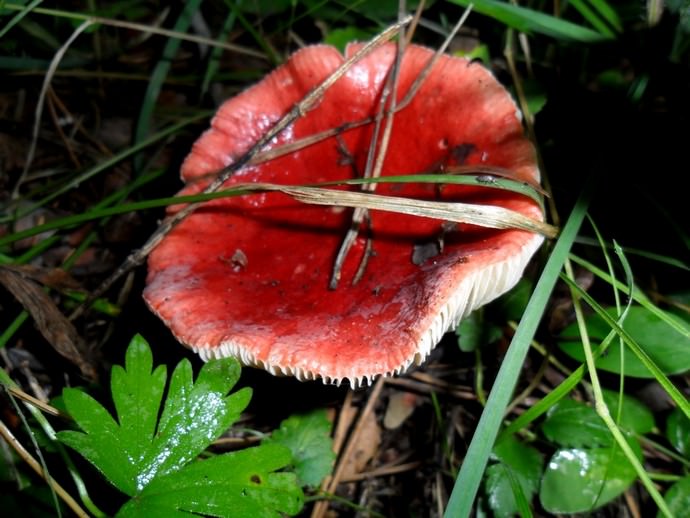
Cooking methods
There are several ways to cook and preserve russula for the winter. They are salted, pickled, frozen, fried and stewed. Harvesting does not take much time, since these mushrooms are easy to clean and wash.

Salted russula
The russula is most often used as a pickling mushroom.
Ingredients:
- Mushrooms (raw) - 1 kilogram;
- Water - 1 liter;
- Salt - 60 grams;
- Carnation - 5 pieces;
- Allspice (peas) - 10 pieces;
- Bay leaf - 5 pieces.
Cooking method:
- Peel the mushrooms, leave in cold water for two hours, then rinse well.
- Put salt, spices and mushrooms in boiling water.
- After the mushrooms settle to the bottom of the pan, they must be removed from the heat, put in jars, filled with brine and closed with plastic lids.

Pickled russula
Ingredients:
- Mushrooms (raw) - 1 kilogram;
- Water - 0.5 liters;
- Salt - 1 tablespoon;
- Sugar - 1 teaspoon;
- Acetic acid - 1 teaspoon
- Carnation - 5 pieces;
- Black pepper (peas) - 10 pieces;
- Bay leaf - 5 pieces;
- Dill seeds - 1 teaspoon
Cooking method:
- Bring the water to a boil, add salt, sugar, spices and add the mushrooms.
- After boiling the mushrooms for 20 minutes, you need to arrange them in sterilized jars, pour marinade and seal them with plastic lids.
Store mushrooms in the refrigerator or cellar. Canned russula are ready to eat within ten days after preparation. A wide variety of dishes can be prepared from them.
Preliminary preparation
How to salt russula - inexpensive, fast and tasty
The russula have one property - the pulp of these mushrooms, especially some of the species, tends to be bitter, so eating them raw will not work, and before cooking russules for food, they must undergo special training.
The rules for the preliminary preparation of these mushrooms are not at all complicated, but in order for russules to be properly salted, they cannot be neglected.
It is important to remember that each type of russula has its own taste characteristics - some require more effort in preliminary preparation, others less - everything is decided depending on the specific type.Therefore, before you start cooking mushrooms, you definitely need to have information about the features of the type of russula that you want to cook
Fruit bodies must be carefully examined and sorted out, removing rotten, overripe or overly damaged specimens.
The mushrooms must be peeled and rinsed under running water using a small brush to remove stubborn dirt.
The peel from the cap must be carefully removed - it is she, most often, the source of most of the bitterness. At the same time, be careful, as the cap of the Russula easily crumbles.
For the final elimination of bitterness from the pulp of mushrooms, the fruit bodies must be soaked in water
The period of soaking depends on the type of mushroom, and can be from 6 to 24 hours. At the same time, the water should be changed approximately every 3 hours. After soaking, the fruiting bodies must be rinsed under running water.
Too large specimens are cut into 2 - 3 parts. Small ones can be left as they are. The main thing is that all individual pieces are the same size - then they will be salted evenly.
You can use enamel and glassware, but they don't like iron russula and can turn black.
It is important, in the future, to follow the rules for storing homemade pickles. Usually they are stored in a refrigerator or cellar, where the temperature regime must be maintained from 0 to +8 degrees.
Also, do not forget about sterilizing the jars in which you will place the russula. Violation of sterilization technology is a very dangerous thing, often leading to very unpleasant consequences. Usually glass jars for pickles are sterilized twice - just before placing the product in them, and immediately after closing the lids.
There are many not at all complicated recipes for salting russula for the winter, and this article presents some of them.
Please note that some recipes use mushrooms that have already undergone special processing, while others this processing is part of the recipe.
Description of the russula marsh
The diameter of the cap of the float is quite large, 5-15 centimeters. The shape of the cap in young marsh russula is bell-shaped or hemispherical, but with age it becomes prostrate, depressed with a ribbed lowered edge. The surface of the cap is shiny, sticky. The color is orange-red, bright red, while the middle is darker - red-brown. Sometimes the cap fades and becomes covered with light ocher spots.

The peel is easily removed to the very center of the cap. The pulp is white, its taste is sweet, only young plates can be a little pungent. The plates are wide, adherent, often located. The shape of the plates is forked, sometimes there are jagged edges. The color of the plates is white, later it becomes yellowish, while the tips may be pinkish. The spore powder is pale yellow.
The length of the leg is 5-8 centimeters, the diameter varies from 1 to 3 centimeters. The shape of the leg is cylindrical, sometimes swollen. The leg is dense in structure, inside it can be made or hollow. The color of the leg is white with a pinkish tinge, its surface is slightly shiny.
Places of distribution of marsh russula
Most often, floats can be found in coniferous forests. These mushrooms actively bear fruit in the summer and autumn months - from June to September. They grow in damp pine forests, along the banks of swamps and on peaty-sandy moist soils. Form mycorrhiza with pines.

Other members of the genus
Black russula or black podgruzdok is a conditionally edible mushroom. The shape of the cap is initially convex in this mushroom, but over time it becomes depressed and funnel-shaped. Its diameter is 5-15 centimeters. The color of the cap is dark brown or dirty brown. The leg is dense in length from 3 to 6 centimeters, the same color as the cap, but lighter.
Black russula are found mainly in pine forests. They grow in groups. Fruiting from July to October. They prefer acidic soils.These are mushrooms of the 4th category, which are suitable only for pickling, their taste is pleasant, sweetish. During salting, they darken.
The russula is pungent, or pungent, or emetic - a conditionally edible mushroom. The shape of the cap is initially convex, later more extended. The skin is smooth, easily detached from the cap, becomes sticky in wet weather. The color of the cap ranges from light pink with white spots to bright red. The leg is cylindrical, strong, dense, covered with a network of wrinkles.
These mushrooms are found on peat bogs, in swampy areas, in mountainous areas. They prefer deciduous forests, less often they can be found in coniferous forests. They bear fruit from summer to autumn.

The russula is fiery in taste and belongs to the 4th category. These mushrooms are only suitable for pickling, and when fresh they are tough. Their taste is pungent, so they were previously considered poisonous. According to some reports, muscarine was found in the composition of the burning russula. These mushrooms are salted after boiling for 20 minutes, the broth should be drained. When salted, they darken a little.
External description of birch russula.
The fruit body of the birch russula is fleshy, it consists of a leg and a cap. The cap is very fleshy and brittle at the same time. Its diameter is 2-5 centimeters. In immature fruiting bodies, the edges of the caps are wavy. As they grow older, the cap becomes slightly depressed. Its color can be different - from copper to reddish, but most often it is pink-lilac with a yellowish tinge. In high humidity, the cap becomes spotty and its color becomes creamy. The top skin of the cap is easily removed.
The flesh of the birch russula is very fragile. The color of the pulp is white. The smell of the pulp is weak, and the taste is pungent. The hymenophore of the birch russula is lamellar. It is formed by thin and sparse plates. The structure of the plate is brittle. They grow together a little with the surface of the leg. The edges of the plates are uneven. The color of the plates is white. Spore white powder. Spores are ovoid.
The legs of birch russula at a young age are very dense, and after rain they become very brittle, as they become soaked. Most often, the thickness of the leg is the same, but sometimes the upper part of it is thinner. The color of the leg is yellowish or whitish. The surface of the leg is wrinkled. Inside, it is hollow, especially in adulthood.
Places of growth of birch russula.
Birch russula are common in Northern Europe. These mushrooms got their name because they grow in birch forests, they are also found in deciduous-coniferous forests, in which there are many birches.
Birch russula prefer wet places; they can be found on sphagnum and in marshy areas. This species is common in Russia, Great Britain, Scandinavia, Belarus. Birch russules begin to bear fruit in July and end in the first half of autumn.
Evaluation of the edibility of birch russula.
Birch russula are classified as conditionally edible, but some mycologists consider them inedible. It is not recommended to consume birch russula raw, as they can cause gastrointestinal upset. Toxic substances are contained only in the upper film, which covers the fruiting body, if the film is removed, then the mushrooms will be safe.

